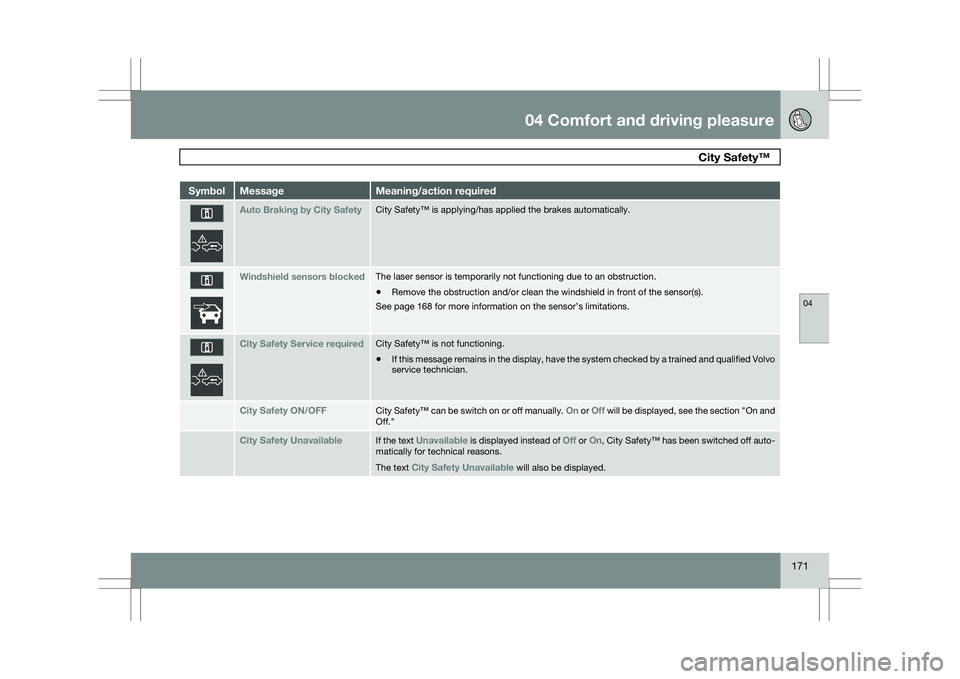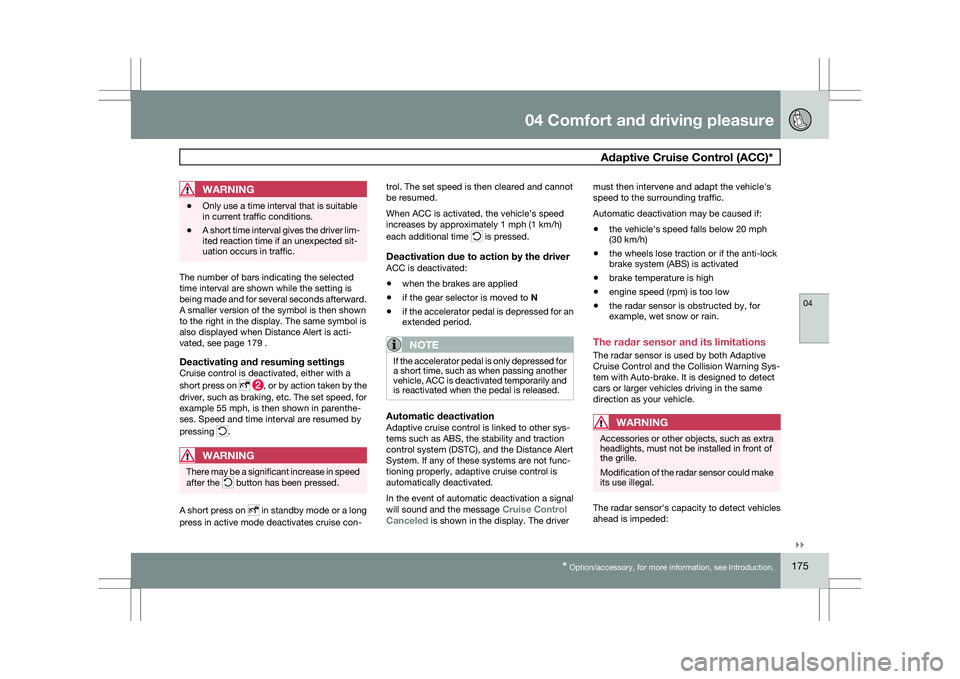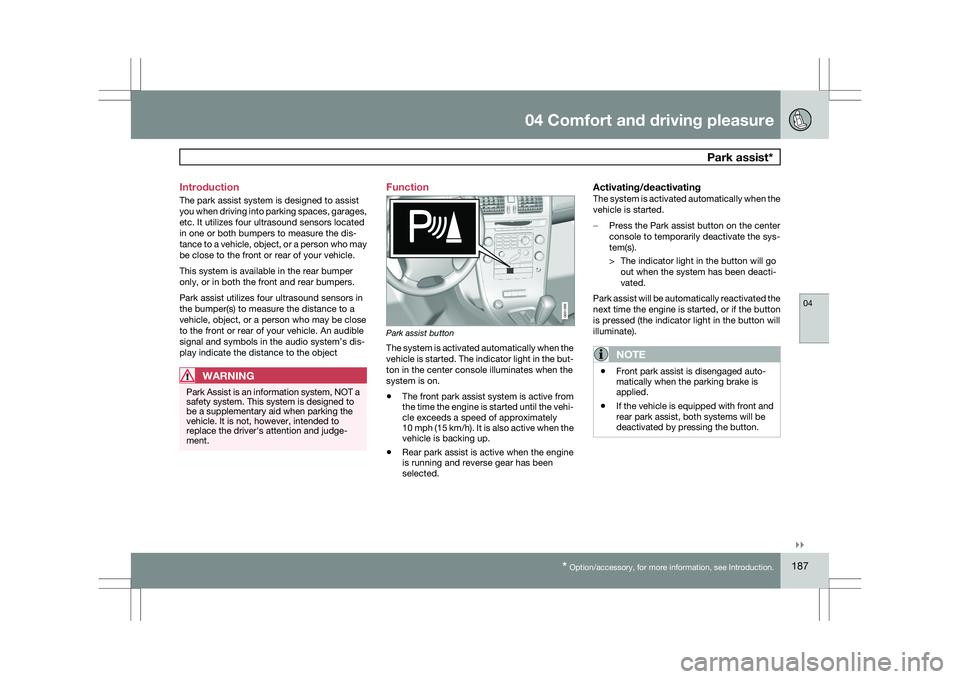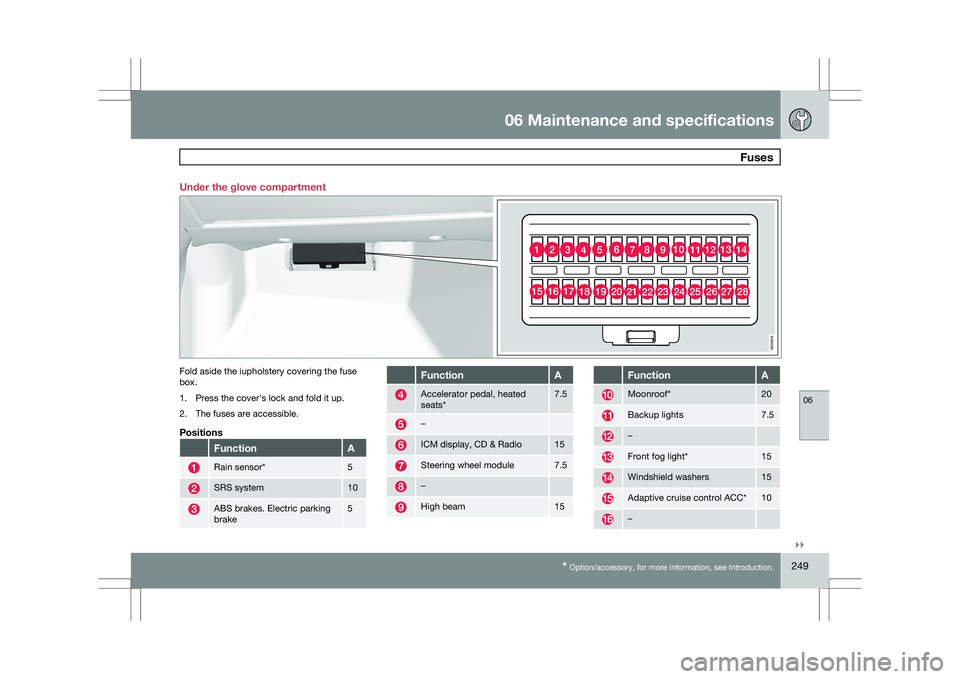brake sensor VOLVO XC60 2009 Owner´s Manual
[x] Cancel search | Manufacturer: VOLVO, Model Year: 2009, Model line: XC60, Model: VOLVO XC60 2009Pages: 297, PDF Size: 21.16 MB
Page 172 of 297

04 Comfort and driving pleasureCity Safety™ 04
170 Maximum pulse energy 2.64 μJ
Maximum average output 45 mW
Pulse length 33 ns
Divergence (horizontal × verti-
cal) 28° × 12°
NOTE
The function of aftermarket laser detectors
may be affected by City Safety\fs laser sen-
sor.
WARNING
The laser sensor emits light when the igni-
tion is in mode II or higher, even if City
Safety™ has been switched off.
WARNING Eye injury may occur if any of the following
points are not followed:
\b
It is essential that all pertinent instruc-
tions be followed when handling laser
instruments. Testing, repairing, remov-
ing, adjusting and/or replacing any
components in the laser sensor may
only be done by a trained and qualified
Volvo service technician.
\b Do not remove the laser sensor (includ-
ing removal of the lenses). A laser sen-
sor that has been removed belongs to
laser class 3B according to standard
IEC 60825-1. Devices in laser class 3B
present a risk of injury to the eyes.
\b The laser sensor’s connector must be
disconnected before the sensor is
removed from the windshield.
\b The laser sensor must be mounted in
place on the windshield before con-
necting the sensor’s connector.
\b Do not view the laser sensor (which
emits spreading, invisible laser beams)
with optical instruments from a distance
of less than 4 inches (100 mm). Symbols and messages in the display
When City Safety™ automatically applies the
brakes, one or more of the symbols in the main
instrument panel may illuminate and its asso-
ciated message will be displayed.
A text message can be erased by pressing
briefly on the READ button on the turn signal
lever.
Page 173 of 297

04 Comfort and driving pleasure
City Safety™ 04
171Symbol Message Meaning/action required
Auto Braking by City Safety City Safety™ is applying/has applied the brakes automatically.
Windshield sensors blocked The laser sensor is temporarily not functioning due to an obstruction.
\b
Remove the obstruction and/or clean the windshield in front of the senso\
r(s).
See page 168 for more information on the sensor’s limitations. City Safety Service required City Safety™ is not functioning.
\b
If this message remains in the display, have the system checked by a tra\
ined and qualified Volvo
service technician. City Safety ON/OFF City Safety™ can be switch on or off manually.
On or Off will be displayed, see the section "On and
Off." City Safety Unavailable If the text
Unavailable is displayed instead of Off or On,
City Safety™ has been switched off auto-
matically for technical reasons.
The text City Safety Unavailable will also be displayed.
Page 175 of 297

04 Comfort and driving pleasure
Adaptive Cruise Control (ACC)*04
}}
* Option/accessory, for more information, see Introduction. 173
WARNING\b
Adaptive cruise control is not a collision
avoidance system. The driver is always
responsible for applying the brakes if
the system does not detect another
vehicle.
\b Adaptive cruise control does not react
to slow moving or stationary vehicles. The distance to the vehicle ahead (in the same
lane) is measured by a radar sensor. Your vehi-
cle\fs speed is regulated by acceleration and
braking. The brakes may emit a sound when
they are being modulated by the adaptive
cruise control system. This is normal.
WARNING
The brake pedal moves when the adaptive
cruise control system modulates the
brakes. Do not rest your foot under the
brake pedal.
The adaptive cruise control system is designed
to follow the vehicle ahead of you in the same
lane, at a set time interval.
If the radar sensor has not detected a vehicle
ahead, the system will then attempt to maintain
the set speed. This is also the case if the speed of the vehicle ahead exceeds the speed that
you have set.
The adaptive cruise control system is designed
to smoothly regulate speed. However, the
driver must apply the brakes in situations that
require immediate braking. This applies when
there are great differences in speed between
vehicles, or if the vehicle ahead brakes sud-
denly.
WARNING
Due to limitations in the radar sensor, brak-
ing may occur unexpectedly or not at all,
see page 175.
Adaptive cruise control can only be activated
at speeds above 20mph (30 km/h). If speed
falls below 20 mph (30 km/h) or if engine speed
(rpm) becomes too low, adaptive cruise control
disengages and will no longer modulate the
brakes. In situations when adaptive cruise con-
trol cannot be activated Cruise Control
Unavailable is shown in the display.
WARNING
When adaptive cruise control disengages,
the brakes will not be modulated automati-
cally. The driver must assume full control
over the vehicle.
Warning light-driver braking requiredAdaptive cruise control has a braking capacity
that is equivalent to approximately 30% of the
vehicle\fs total braking capacity. In situations
requiring more brake force than ACC can pro-
vide, if the driver does not apply the brakes, an
audible signal will sound and a red warning
light will illuminate in the windshield to alert the
driver to react.
NOTE Strong sunlight, reflections, extreme light
contrasts, the use of sunglasses, or if the
driver is not looking straight ahead may
make the visual warning signal in the wind-
shield difficult to see.
WARNING
Cruise control only warns of vehicles
detected by the radar sensor, see
page 172. In some cases there may be no
warning or the warning may be delayed. The
driver should always apply the brakes when
necessary.
Page 177 of 297

04 Comfort and driving pleasure
Adaptive Cruise Control (ACC)*04
}}
* Option/accessory, for more information, see Introduction. 175
WARNING\b
Only use a time interval that is suitable
in current traffic conditions.
\b A short time interval gives the driver lim-
ited reaction time if an unexpected sit-
uation occurs in traffic. The number of bars indicating the selected
time interval are shown while the setting is
being made and for several seconds afterward.
A smaller version of the symbol is then shown
to the right in the display. The same symbol is
also displayed when Distance Alert is acti-
vated, see page 179 .
Deactivating and resuming settingsCruise control is deactivated, either with a
short press on
, or by action taken by the
driver, such as braking, etc. The set speed, for
example 55 mph, is then shown in parenthe-
ses. Speed and time interval are resumed by
pressing .
WARNING
There may be a significant increase in speed
after the
button has been pressed.
A short press on in standby mode or a long
press in active mode deactivates cruise con- trol. The set speed is then cleared and cannot
be resumed.
When ACC is activated, the vehicle’s speed
increases by approximately 1 mph (1 km/h)
each additional time is pressed.
Deactivation due to action by the driverACC is deactivated:
\b
when the brakes are applied
\b if the gear selector is moved to
N
\b if the accelerator pedal is depressed for an
extended period.
NOTE If the accelerator pedal is only depressed for
a short time, such as when passing another
vehicle, ACC is deactivated temporarily and
is reactivated when the pedal is released.
Automatic deactivationAdaptive cruise control is linked to other sys-
tems such as ABS, the stability and traction
control system (DSTC), and the Distance Alert
System. If any of these systems are not func-
tioning properly, adaptive cruise control is
automatically deactivated.
In the event of automatic deactivation a signal
will sound and the message
Cruise Control
Canceled is shown in the display. The driver must then intervene and adapt the vehicle\fs
speed to the surrounding traffic.
Automatic deactivation may be caused if:
\b
the vehicle\fs speed falls below 20 mph
(30 km/h)
\b the wheels lose traction or if the anti-lock
brake system (ABS) is activated
\b brake temperature is high
\b engine speed (rpm) is too low
\b the radar sensor is obstructed by, for
example, wet snow or rain.
The radar sensor and its limitations
The radar sensor is used by both Adaptive
Cruise Control and the Collision Warning Sys-
tem with Auto-brake. It is designed to detect
cars or larger vehicles driving in the same
direction as your vehicle.WARNING Accessories or other objects, such as extra
headlights, must not be installed in front of
the grille.
Modification of the radar sensor could make
its use illegal.
The radar sensor\fs capacity to detect vehicles
ahead is impeded:
Page 178 of 297

04 Comfort and driving pleasureAdaptive Cruise Control (ACC)* 04
176
* Option/accessory, for more information, see Introduction.
\b
if the radar sensor is obstructed and can-
not detect other vehicles, for example in
heavy rain, or if snow or other objects are
obscuring the radar sensor.
NOTE Keep the area in front of the radar sensor
clean.
\b
if the speed of vehicles ahead is signifi-
cantly different from your own speed.
WARNING The radar sensor has a limited field of vision.
In some situations it may detect a vehicle
later than expected or not detect vehicles at
all.
Radar sensor field of vision (gray)
In certain situations, the radar sensor can-
not detect vehicles at close quarters, for
example a vehicle that suddenly enters thelanes between your vehicle and the one
that the system has already detected. Small vehicles, such as motorcycles, or
vehicles not driving in the center of the lane
may remain undetected.
In curves, the radar sensor may detect the
wrong vehicle or lose a detected vehicle
from view.
Fault tracing and actions
If the message Radar blocked See manual is
displayed, this means that the radar signals
from the sensor have been obstructed and that
a vehicle ahead cannot be detected.
This, in turn, means that the functions of the
ACC, Distance Alert, and Collision Warning
System with Auto-brake will not function.
The table lists possible causes for this mes-
sage being displayed, and suitable actions. Cause Action
The surface of the radar in the grille is dirty or obstructed in some wa\
y. Clean the radar surface, or remove the object causing the obstruction.
Heavy rain or snow is interfering with the radar signals. No action possible. Heavy precipitation may affect the function of the
radar. G02141
4
Page 179 of 297

04 Comfort and driving pleasure
Adaptive Cruise Control (ACC)*04
}}
* Option/accessory, for more information, see Introduction. 177Cause Action
Swirling water or snow from the surface of the road may interfere with
the radar signals. No action possible. A very wet or snow-covered road surface may affect
the function of the radar.
The surface of the radar is clean but the message remains in the display\
. Wait a short time. It may take several minutes for the radar to detect t\
hat
it is no longer obstructed.
Symbols and messages in the display
Symbol Message Description
- Standby mode or active mode when no other vehicle has been detected.
- Active mode with a detected vehicle to which ACC is adapting speed/dista\
nce.
- Time interval while it is being set.
- Time interval after it has been set.
-
Turn on DSTC
to enable Cruise ACC cannot be activated until the stability system (DSTC) has been act\
ivated. See page
155 for more
information on DSTC. -
Cruise control canceled ACC has been automatically switched off.
The driver must regulate the vehicle’s speed/distance to the vehicle \
ahead.
-
Cruise control unavailable ACC cannot be activated. This may be due to:
\b
high brake temperature
\b the radar sensor is obstructed (by heavy rain, snow, etc.)
Page 183 of 297

04 Comfort and driving pleasure
Distance alert04
181Symbol Message Description
Radar blockd
See manual Distance Alert has been temporarily disconnected because the radar is ob\
structed in some way and
cannot detect other vehicles.
See page 175 for information on the radar sensor’s limitations.Collision warn.
Service required Distance Alert or Collision Warning with Auto-brake is not functioning p\
roperly. Contact a trained and
qualified Volvo service technician.
Page 189 of 297

04 Comfort and driving pleasure
Park assist*04
}}
* Option/accessory, for more information, see Introduction. 187
Introduction
The park assist system is designed to assist
you when driving into parking spaces, garages,
etc. It utilizes four ultrasound sensors located
in one or both bumpers to measure the dis-
tance to a vehicle, object, or a person who may
be close to the front or rear of your vehicle.
This system is available in the rear bumper
only, or in both the front and rear bumpers.
Park assist utilizes four ultrasound sensors in
the bumper(s) to measure the distance to a
vehicle, object, or a person who may be close
to the front or rear of your vehicle. An audible
signal and symbols in the audio system’s dis-
play indicate the distance to the object
WARNING
Park Assist is an information system, NOT a
safety system. This system is designed to
be a supplementary aid when parking the
vehicle. It is not, however, intended to
replace the driver\fs attention and judge-
ment. Function
Park assist button
The system is activated automatically when the
vehicle is started. The indicator light in the but-
ton in the center console illuminates when the
system is on.
\b
The front park assist system is active from
the time the engine is started until the vehi-
cle exceeds a speed of approximately
10 mph (15 km/h). It is also active when the
vehicle is backing up.
\b Rear park assist is active when the engine
is running and reverse gear has been
selected.
Activating/deactivatingThe system is activated automatically when the
vehicle is started.
–
Press the Park assist button on the center
console to temporarily deactivate the sys-
tem(s).
> The indicator light in the button will go
out when the system has been deacti-
vated.
Park assist will be automatically reactivated the
next time the engine is started, or if the button
is pressed (the indicator light in the button will
illuminate).
NOTE \b
Front park assist is disengaged auto-
matically when the parking brake is
applied.
\b If the vehicle is equipped with front and
rear park assist, both systems will be
deactivated by pressing the button. G031399
Page 191 of 297

04 Comfort and driving pleasure
Park assist*04
* Option/accessory, for more information, see Introduction. 189
Front park assistThe distance monitored in front of the vehicle
is approximately 2.5 ft (0.8 m). The audible sig-
nal comes from the audio system\fs front
speakers.
It may not be possible to combine auxiliary
headlights and front park assist since these
lights could trigger the system\fs sensors.
Faults in the system
If the information symbol illuminates and
Park
Assist syst Service required is shown on the
information display, this indicates that the sys-
tem is not functioning properly and has been
disengaged. Consult a trained and qualified
Volvo service technician.CAUTION In certain circumstances, the park assist
system may give unexpected warning sig-
nals that can be caused by external sound
sources that use the same ultrasound fre-
quencies as the system. This may include
such things as the horns of other vehicles,
wet tires on asphalt, pneumatic brakes,
motorcycle exhaust pipes, etc. This does
not indicate a fault in the system.
Cleaning the sensors
Location of the front sensors Location of the rear sensors
The sensors must be cleaned regularly to
ensure that they work properly. Clean them
with water and a suitable car washing deter-
gent.
Ice and snow covering the sensors may cause
incorrect warning signals.
NOTE
If the sensors are obstructed by e.g., dirt,
snow, or ice, this could result in false warn-
ing signals from the park assist system. G031401 G031402 G031403
Page 251 of 297

06 Maintenance and specifications
Fuses06
}}
* Option/accessory, for more information, see Introduction. 249
Under the glove compartment
Fold aside the iupholstery covering the fuse
box.
1. Press the cover\fs lock and fold it up.
2. The fuses are accessible.
Positions
Function A
Rain sensor* 5
SRS system 10
ABS brakes. Electric parking
brake 5 Function A
Accelerator pedal, heated
seats* 7.5
–
ICM display, CD & Radio 15
Steering wheel module 7.5
–
High beam 15 Function A
Moonroof* 20
Backup lights 7.5
–
Front fog light* 15
Windshield washers 15
Adaptive cruise control ACC* 10
– 1011121314123456789
2322212019181716152425262728
G032918